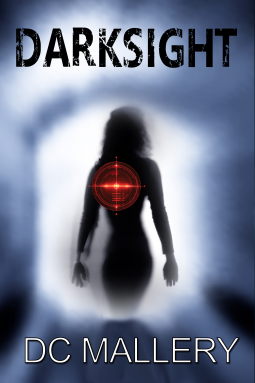
Darksight by D. C. Mallery
Genre: Fantasy/Medical Thriller
Publisher: Black Opal Books
Publication Date: June 8, 2019
Summary:
Audra, a blind woman in her twenties, has found an empowering life in New York City after the car accident that killed her mother and blinded her. She’s a deejay, rides bikes, and navigates the world with the help of her guide dog and an uncannily-strong blindsight. She’s content.
But her father, Jenson, is obsessed with restoring his daughter’s sight. A neuroscientist, he has developed a procedure that could give sight to those with cortical blindness. Aided by a strange, ant-obsessed colleague named Stefan, Jenson has obtained funding for his project; after a series of tests, he has a group of possible test subjects, all showing high levels of blindsight. Though Audra wants no part of the procedure, she feels she owes it to her father and the other test subjects to participate.
It fails. Or seems to.
Then Audra begins to have dreams. Visual dreams, like what she had before the accident. She begins to “see” but her new sight is unreliable. Worse, her well-developed blindsight appears to be failing her.
Then several of the test subjects die, their bodies mutilated. Jenson is alarmed. There’s obviously a link between the deaths: his experimental procedure. The police suspect him. Yet Jenson’s convinced that his project was hijacked for less-than-altruistic motives and that the procedure has unleashed a mysterious new element: darksight.
Then Audra is kidnapped. Her captors want to use her darksight for their own gain. But what is it? Can she learn to use darksight to escape and protect herself and her father?
Thanks to Netgalley, Black Opal Books, and D. C. Mallery for a copy of Darksight in exchange for an honest review.
My thoughts:
In a word: freaky. While this is fantasy, there’s a realistic edge. Whenever science proclaims medical “progress”, there is the flip side: what are we giving up in exchange for the cure? Are the side effects worth the treatment? Or is the cure worse than the illness?
What worked for me:
The father-daughter relationship
Jenson, consumed by guilt from the accident that caused his daughter’s blindness, obsesses over curing her. But Audra’s content with her freedom and empowering lifestyle and wrestles against her father’s will. He wants to cure her; she doesn’t want to be cured.
It’s the age-old child-parent tug-of-war, freedom versus protection, with the complication of blindness, both literal and metaphorical. They love each other, but neither truly understands the other’s concerns.
The scientific/medical aspect
Mallery does a great job integrating and explaining the complicated science of sight and blindness. Some people have cortical blindness: the optic nerves and retina function, but the visual cortex (part of the brain that processes vision) is damaged. “Blindsight,” Jenson explains, is the ability among some with cortical blindness “to sense objects even though they have no visual field, even if totally blind” (chapter 2). That’s how Audra is able to ride her bike, work her way through complicated mazes, and find her way through New York City.
This is fascinating. As best I can tell, it’s all true, too. It’s not echolocation (like bats have).
The protagonists
It’s easy to root for Audra. She’s snarky, spunky, good at yanking other people’s chains, reckless, and empathetic. She was an art major (!) who’s made a life for herself and refuses to give up her independence, even for her father. Just as importantly, she’s empathetic and a natural leader. Though she doesn’t want to undergo the procedure, her reasons for doing so make sense.
Jenson is also easy to care about. What dad wouldn’t want his daughter’s sight restored? Who wouldn’t feel consumed by guilt over the accident that killed his wife and blinded his daughter? What person wouldn’t develop a bit of a blindspot, tunnel vision over their scientific quest?
The plot
Mallery cranks up the tension over and over and over. I stayed up late reading because I needed to find out what happens. Ironically, this happened even though I’d read the ending first: I needed to see all the story dots connected, and I couldn’t bear to leave Audra and company in danger over night.
What didn’t work for me:
The antagonistic characters
In my opinion, Mallery doesn’t quite develop all of the antagonistic characters in depth, unfortunately. But people like Sasha (the blind stripper with snake tattoos) and Stefan (Jenson’s colleague with the massive ant colonies) are given more development and a chance at redemption. (Though whether either will take that chance is a different story!)
Some of the other test subjects feel a bit cliched. Connie, for example, seemed a stereotype of an overly devout woman. Frank Parker feels over-the-top as a blind, paranoid, bad-to-the-bone attack dog trainer.
Some of the writing quirks
Frequently, words are italicized for emphasis. It’s a style quirk that I personally dislike, as I don’t need the author to stress which words should be emphasized: my mental reading “voice” fills that in well enough.
There are a few typos, as well. “Gate” instead of “gait”, “now” instead of “know”, that sort of thing.
Whether either of these are things that other readers notice or care about, I don’t know. But they distracted me.
Overall, a good thriller.
For fans of fantasy thrillers and those who love a spooky read, Darksight will please you and make you think.
Bonus tip for writers
Have an incredible unbelievable fantastical element you need the readers to believe?
Build a solid basis for belief.
Mallery does this well.
In the opening chapters, Jenson explains the concepts of cortical blindness, blindsight, and how normal sight works. He does this multiple times, actually, through a school newspaper interview and through presentations to the possible test subjects. Each time, he adds a bit more information, a bit more dimension, so we’re not overwhelmed by all the science. It all makes sense to us.
Then Mallery introduces the supernatural idea of “darksight.” But Jenson’s scientific background allows him to figure out what has happened and why. Because we’ve trusted Jenson to give us proven scientific information, we trust his explanations about darksight.
This review also appears on Goodreads and Bookbub. It will appear on Amazon and Barnes & Noble’s website on the publication day.
